| |
|
|
Muskoka Magazine:
Article by Barry Grills/Photographs by Jan Pitman 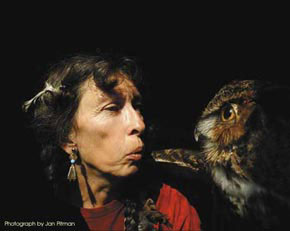 Mi-Shell Jessen keeps a stuffed Great Horned Owl at her home. It is a Shamanic family totem, a medicine animal, which had meaning on both sides of her family. Mi-Shell Jessen keeps a stuffed Great Horned Owl at her home. It is a Shamanic family totem, a medicine animal, which had meaning on both sides of her family.
There's a kind of basic interconnectedness about the various aspects of Mi-Shell Jessen's life, work, and cultural roots. No one aspect of it would be complete without the other. As a healer, as a teacher, as an indigenous Siberian, Mi-Shell Jessen brings the worlds of animism, modern experience and cultural history together.
Mi-Shell and her husband, Peter, live down the Fraserburg Road, not far from Bracebridge. They have lived on 106 acres of wilderness land there for about 15 years. From their deck, one can see over a valley veined by a creek. On this property there is a small pack of wolves. There are bears. There are moose. There are owls and other birds. It's an appropriate setting for a woman whose history, both paternally and maternally, has its roots in Shamanism.
While the words shaman and Shamanism are terms often used to describe First Nations medicine men in North America, when Mi-Shell Jessen explains Shamanism resides in the genealogy of both sides of her family, she is very speciffically talking about her geographical roots in Siberia.
In fact, the Oxford Dictionary defines Shamanism as: "The primitive religion of the Ural-Altaic peoples of Siberia, in which all the good and evil of life are thought to be brought about by spirits which can be influenced only by shamans."
Mi-Shell was raised in the tradition of Shamanism on both sides of her family as an indigenous Siberian, and she has combined this cultural tradition with training both as a registered nurse and a Jungian therapist.
"It's a way of life, of seeing the world," Mi-Shell will tell you. "It's in our blood."
She can trace the art of being a shaman back to 1826. On both sides of her family there were practicing shamans where her family originated in Tuva, Siberia. Tuva is located in southern Siberia, on the borders of China, to the east of Afghanistan. She is proud to say she follows in the footsteps of her grand-mother who was the healer-shaman of her tribe there.
For Mi-Shell, though, the Shamanism in her blood is complemented by more conventional modern approaches to healing.
She views herself as bringing three different approaches to teaching and healing: the tradition of Shamanism, conventional nursing skills and a Jungian approach to human well-being.
"When you combine all three, you get the best of both worlds," she says. But how does this complementary package form itself? For Mi-Shell Jessen, it all began in Germany in the post-war period. While her roots are indigenous Siberian, she grew up in West Germany.
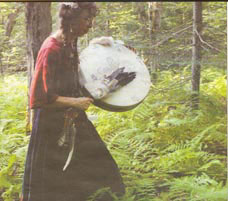 Mi-Shell Jessen plays a drum while she walks through the forest near her home. She teaches drumming and makes her own traditional drums. Mi-Shell Jessen plays a drum while she walks through the forest near her home. She teaches drumming and makes her own traditional drums.
Her family ended up there after her grandfather fled to Prussia from Siberia to escape the persecution the indigenous people faced at the hands of the Russians.
During the Second World War her father met a Gypsy woman in a concentration camp who would later become his wife and bear him a child - Mi-Shell - who followed in his Shamanic footsteps.
"I grew up in my father's traditions, but my mother said, 'No, no, don't teach her anything, don't tell her anything, don't say anything,' because my mom was very frightened. She had been in a concentration camp and barely survived. But my father said, 'Oh, she needs to know who she is and what she is and the traditions."
Mi-Shell continued to follow her Shamanic heritage and refused to convert to Christianity. Her unwavering commitment to her heritage and its belief system landed her in a Catholic orphanage in Germany to be Christianized.
Perceived as a pagan - much in the way North American native peoples were forcibly compelled to adopt Christian beliefs in residential schools - she suffered "torture," she says.
In fact, as a little girl, she went through an exorcism, which included putting holy water in all of her orifices. At the hands of her tormenters she also suffered welts that became infected. She says her spirit never wavered under this cruelty; the spirits she grew up with were the only thing left to her.
However, when she was returned to her family, her mother, who was fearful for her safety, encouraged her to pursue more conventional training in more conventional settings.
Degrees in nursing and Jungian analysis followed. The latter is a type of psychotherapy that explores the imagination to develop the unconscious. Jung believed that a disconnect between the conscious and the unconscious mind will lead to psychotic disorders.
When she came to Canada about 20 years ago, she studied in Ottawa, updating her registered nursing degree to Canadian standards. As a result she is able to apply aspects of all three approaches to the art of healing. She is also able to maintain good working relationships with local doctors and bring the spiritual, the psychiatric, and the conventional medical approaches to whatever problem with which a patient must deal.
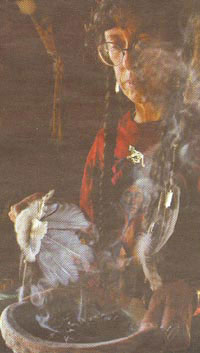 Sage,cedar and juniper berries are burned in a smudging shellduring a purification ceremony. Sage,cedar and juniper berries are burned in a smudging shellduring a purification ceremony.
Mi-Shell considers herself a specialist in the technique of utilizing trances to seek well-being for her patients. But there is no incongruity between the three approaches she uses in healing. She is quick to point out, should a person have a broken leg, modern techniques of repairing that injury are best for a patient. Or if the person has cancer, modern approaches to treating cancer are best. In these cases, psychiatric approaches and Shamanistic techniques complement modern medical procedures to enhance the well-being of the patient. It's not a case of the traditional supplanting the modern or vice versa.
At the same time, Mi-Shell feels it is positive these days that native cultures are "coming out from under the oppression" that they have known· in the past. Not only do students of indigenous cultures learn about their history, but indigenous cultures have things to teach our modern way of life in a larger sense too. And there is fascinating area of knowledge that surfaces when the cultures of first peoples are explored, namely what we can learn from their staggering similarities.
Mi-Shell has a room in her home with a detailed display that demonstrates the extent of the comparisons between indigenous Siberian tribes and native peoples of North America. She maintains that most of the legends, lores, animist conclusions, and spiritual totems are 80 per cent the same, whether they be Siberian, North American, or even Celtic.
In her home, one display shows the various items that make up a traditional Siberian indigenous collection of totems displaying direction, the various spirits and other aspects connected to a Shamanistic healing circle. The other display is North American. The similarity is striking and the adherence to the importance of animals goes without saying. Bear, for example, is always in the east in both cases. Yet, for thousands of years, these two cultures lived a vast distance from one another.
At the same time, there can be differences in the two cultures. Where sweet grass is available in North America as a powerful spiritual and healing tool, Mi- Shell says she would have used juniper berries in her Siberian setting instead .
As a woman who teaches drumming and makes her own traditional drums, here too she can demonstrate some contrasts. The North American drum does not vibrate well in the humidity. The Siberian drum, however, has so much force, vibrations can be felt as she demonstrates the power of its sound.
Another contrast is the reticence of the indigenous Siberian peoples to utilize eagle feathers in ceremonies. In North America, the eagle feather is important to ceremonies but in Siberia a raven feather would be used more often. This time the reason has nothing to do with availability but with a different traditional weight placed upon the eagle feather.
"The eagle feathers are so sacred, you don't fiddle with them ... they're too sacred!" explains Mi-Shell.
Specific animals have a great deal to do with Shamanistic tradition and the culture of healing. In Mi-Shell's case, it is the owl feather that gives her the power to heal. And the bear is the animal who brings new knowledge.
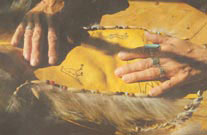 Mi-Shell Jessen makes medicine pouches from wolf and moose hide, incorporating raven feathers into the design. She then adds spiritual drawings, such as the raven, which is a sacred bird. Mi-Shell Jessen makes medicine pouches from wolf and moose hide, incorporating raven feathers into the design. She then adds spiritual drawings, such as the raven, which is a sacred bird.
While Mi-Shell has an important reputation as a healer, and as a teacher who leads circles and gatherings that focus on teaching, healing, ritual, drums and drumming, and human growth and wellbeing, she and her husband are also known for the work they share as Bearpaw Jewellery.
Recognized throughout the area in art shows, and internationally as artists, they apply the cultural tradition of Shamanism with artistry to fashion unique jewelry designs that are faithfully traditional.
Most of the work they sell- which Mi-Shell admits pays the bills that her pro bono healing work does not - is designed, in their words, to celebrate the grace and beauty of wild animals.
At the same time, in the spirit of Mi-Shell's Shamanism, the jewelry attempts to capture the process of animal, to spirit, to human - so often the focus of native myth, world mythology, lore and legend.
Still other works attempt to capture the spiritual essence of what it is to be human. In this way, as the force behind the jewelry making, Peter's interests complement Mi-Shell's. Peter's interests include wildlife, anthropology, pre-history and petroglyphs and pictographs from around the world.
These days Mi-Shell considers herself mostly a teacher and healer. She presents instruction on traditional Shamanistic practices, outlining the comparisons and contrasts between Siberian and North American native peoples.
She also conducts a Shamanistic circle which, due to space at their home, is open only to 24 people. The next circle will begin on the last Saturday of October. Finally, on Tuesday evenings, she holds drumming circles in Bracebridge.
Much of her teaching is done with North America's native peoples. While they sometimes wonder at first if she is assuming their cultural voice, they soon learn she is teaching the lore and knowledge in her own indigenous tradition that is similar to their own. And, as she points out, this is tradition that is similar to the Celtic belief system too.
In a way, this close resemblance between geographically distant cultures and their Shamanic belief systems falls into Carl Jung's view of the collective unconscious. How, otherwise, can cultures so distant from one another share so much, when it comes to the healing power of animism or Shamanism?
There are legends specific to her own area and culture, however. Mi-Shell tells a story from Siberia about the various levels of shaman and the snow leopard test that is part of achieving the ninth level as a shaman. According to legend, a shaman seeking the ninth level must take an offering to a snow leopard. When the snow leopard comes to accept the offering, the shaman must take one of his whiskers. If he manages this and survives, he becomes a ninth-level shaman.
Mi-Shell is busily engaged instructing teachers how to teach native curriculum. While she is not a blood member of Canada's First Nations community, the cultural similarities are such that she can bring much to the instruction. She speaks a number of First Nations languages and here too, as a linguist, she is staggered by the similarities between languages that are quite geographically distant from one another.
If there is a drawback to all the teaching, it is only that it takes her away from her Fraserburg Road home and the 106 acres where she and Peter can be close to nature.
"It (giving talks) takes me away from home. How this will develop in the long run, I don't know," she says. "I prefer to teach in the winter."
Teacher, healer, Jungian analyst, registered nurse. Mi-Shell Jessen is all of these, working in the modern present, yet connected through blood and tradition to a pagan, Shamanistic past. And she's found a way to blend modern and traditional together, so that past meets present in a spiritually relevant way.
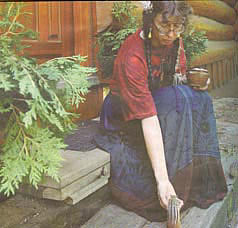 Mi-Shell Jessen feeds a chipmunk in front of her log home near Bracebridge. As a shaman, she is very connected to natural and animal worlds. Mi-Shell Jessen feeds a chipmunk in front of her log home near Bracebridge. As a shaman, she is very connected to natural and animal worlds.
THE
ARTISTS | GALLERY | STUDIO | SHOWS | SHAMANIC
TEACHINGS | LEGENDS | LINKS | HOME |
|
